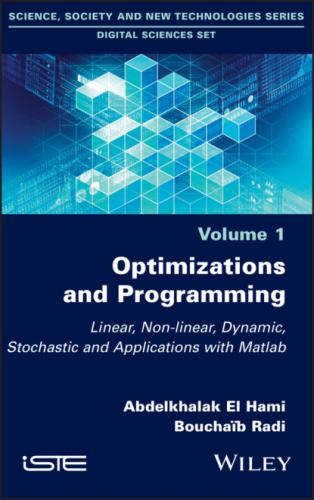212 213
213 214
214 215
215 216
216 217
217 218
218 219
219 220
220 221
221 222
222 223
223 224
224 225
225 226
226 227
227 229
228 231
229 232
230 233
231 234
232 235
233 236
234 237
235 238
236 239
237 240
238 241
239 242
240 243
241 245
242 246
243 247
244 248
245 249
246 250
247 251
248 252
249 253
250 254
251 255
252 256
253 257
254 258
255 259
256 261
257 262
258 263
259 264
260 265
261 266
262 267
263 268
264 269
265 270
266 271
Digital Sciences Set
coordinated by
Abdelkhalak El Hami
Volume 1
Optimizations and Programming
Linear, Nonlinear, Dynamic, Stochastic and Applications with Matlab
Abdelkhalak El Hami
Bouchaib Radi
First published 2021 in Great Britain and the United States by ISTE Ltd and John Wiley & Sons, Inc.
Apart from any fair dealing for the purposes of research or private study, or criticism or review, as permitted under the Copyright, Designs and Patents Act 1988, this publication may only be reproduced, stored or transmitted, in any form or by any means, with the prior permission in writing of the publishers, or in the case of reprographic reproduction in accordance with the terms and licenses issued by the CLA. Enquiries concerning reproduction outside these terms should be sent to the publishers at the undermentioned address:
ISTE Ltd
27-37 St George’s Road
London SW19 4EU UK
John Wiley & Sons, Inc.
111 River Street
Hoboken, NJ 07030
USA
© ISTE Ltd 2021
The rights of Abdelkhalak El Hami and Bouchaib Radi to be identified as the authors of this work have been asserted by them in accordance with the Copyright, Designs and Patents Act 1988.
Library of Congress Control Number: 2020948478
British Library Cataloguing-in-Publication Data
A CIP record for this book is available from the British Library
ISBN 978-1-84821-953-3
Preface
Optimization is the domain of mathematics that studies how to minimize (or maximize) a certain objective, for example, an economic parameter or some type of energy. This is both an ancient topic, with the earliest optimization problems going back to Euclid, and a relatively new topic, with the recent development of numerical methods such as linear programming, which only truly began to flourish in the second half of the 20th century. As an illustration, imagine the problem of searching for a path that joins two points on a map in the shortest time. Some parameters of the problem might be uncertain; for example, we might encounter a traffic jam on the road. Optimization seeks to find the best compromise between the various possible risks.
In the presence of uncertainty, the optimizer (or decider) will often take advantage of information about the system that becomes available dynamically, i.e. gradually over time. For example, we will gradually discover which roads are most susceptible to traffic jams over time, as we try them out. The difficulty of an optimization problem is closely linked to the amount of information needed to make an optimal decision. A problem is said to be large if this quantity of information is too big for classical solving techniques to be applied by brute force.
This book is divided into two parts: programming (Part 1) and optimization (Part 2). In the programming part, we present a collection of tools for operations research, including linear programming, integer programming, binary programming, dynamic programming and stochastic programming. Operations research first arose in the United Kingdom during the Second World War, when scientific methods were used to study various aspects of military operations. Since then, it has become a key element of decision-making processes in various commercial, industrial and governmental contexts, offering a systematic way to apprehend the ever increasing complexity of the management problems faced by both the private and public sectors.
Following its success in military matters during the Second World War, operations research
